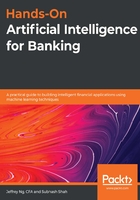
Understanding time series analysis
A time series is technically defined as the ordered sequence of values of a variable captured over a uniformly spaced time interval. Put simply, it is the method of capturing the value of a variable at specific time intervals. It can be 1 hour, 1 day, or 20 minutes. The captured values of a variable are also known as data points. Time series analysis is performed in order to understand the structure of the underlying sources that produced the data. It is also used in forecasting, feedforward control, monitoring, and feedback. The following is a list of some of the known applications of time series analysis:
- Utility studies
- Stock market analysis
- Weather forecasting
- Sales projections
- Workload scheduling
- Expenses forecasting
- Budget analysis
Time series analysis is achieved by applying various analytical methods to extract meaningful information from raw data that has been captured from various data sources. Time series analysis is also useful for producing statistics and other characteristics of data—for example, the size of data, the type of data, the frequency of data, and more. In time series analysis, the capturing of a value is done at a point of observation.
Let's try to understand this through an example. When using time series analysis modeling, the branch manager of a specific branch can predict or forecast the expenses that will occur in the upcoming year. The branch manager can do this by employing a time series analysis machine learning model and then training the model using historical yearly expense records. The recorded observations can be plotted on a graph with a specific time (each day, in this example) on the x axis and historical expenses on the y axis. Therefore, time series analysis is an algorithm that is used to forecast the future values of one variable (that is, yearly expenses in this example) based on the values captured for another variable (in this case, time).
Let's understand this in more detail using another example. In this example, we will imagine that a bank wants to perform expense projections based on the historical data it has. The bank manager wants to know and forecast the expenses in the year 2020 for the branch that he manages. So, the process of forecasting the expenses will start by collecting historical expenses information from the year 2000. First, the bank manager will look at the expenses data for the year.
As we mentioned earlier, time series analysis is done by capturing the values of a variable. Can you guess the variable in this example? I am sure that you will have guessed it by now. The variable under observation is the total expense amount per year. Let's assume that the following is the data per year:

Many options are available to analyze this data and predict future expenses. The analytical methods vary in terms of complexity. The simplest one will be to average out the expenses and assume the resultant value to be the number of expenses for the year 2020. However, this is solely for the purpose of our example. You can find the average of expenses by using various other mathematical and analytical methods as well. With this option, the total number of expenses for the year 2020 will be $20,915.
The complex method may involve analyzing detailed expenses, predicting future values for each individual expense type, and deriving the total expenses amount based on it. This may provide a more accurate prediction than the averaging option. You can apply a more complex analytical method based on your needs. This example is provided so that you can understand how time series analysis works. The amount of historical data that we have used in this example is very limited. AI and machine learning algorithms use large amounts of data to generate predictions or results. The following is a graphical representation of this example:

In the following section, we will learn how machines can communicate with each other using a concept known as M2M communication.